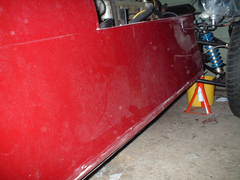mat.price
|
| posted on 29/6/06 at 06:28 PM |

|
|
wet,dry and tool??
Ok wet and dry
What tools can you use?
Whatís the best way to start?
Whatís done first?
Dry sanding or wet sanding?
Whatís the best sand paper for the job?
Is there one for carbon fibre only?
Thank matt
|
|
|
|
|
02GF74
|
| posted on 3/7/06 at 02:32 PM |

|
|
quote:
Originally posted by mat.price
Ok wet and dry
What tools can you use?
Whatís the best way to start?
Whatís done first?
Dry sanding or wet sanding?
Whatís the best sand paper for the job?
Is there one for carbon fibre only?
Thank matt
not sure what the question is
Depending on what you are doing, coarse grade is for removing stuff quickly and to get a smooth finish you would use fine grade.
Sandpaper is really glass bit on paper so has to be used dry or else the paper falls apart.
Alo depends on what you are saniding, you wouldn't use water when sanding wood but for body filler/car paint/glass fibre you would - not sure
why but I think it help to keep the paper clear - also read thjat adding a bit of washing up liquid helps.
For painting you would be ending up with about 800 or 1000 prior to the last coat and if that needs to be flatted, 1200 grade or polishing compound to
finish it off.
|
|
|
DarrenW
|
| posted on 4/7/06 at 08:55 AM |

|
|
Hi mat,
Please give some info on what you would like to do. If you are flatting off a good surface for painting you need far finer grades than if you are
repairing damage. For car bodywork most use wet and dry. A spot of soap in the water helps to lubricate it.
For final flatting before polishing ive used 1200 followed by 2000 grade.
|
|
|
mat.price
|
| posted on 7/7/06 at 05:41 PM |

|
|
What Iím planning to do is to take all the ruff edging of the carbon fibres body
What I donít know is if this is the finished side? I.e. if I sand it down it will look the some as the rest?
Therefore whatís the best sand paper for the job high or low grade or special carbon sand paper?
Tools? I have asked some people about this and some sad to use a heavy-duty sander and blocks!
When starting whatís done first wet or dry and why? I know nothing about this other then the Avon book with lot of help? Not!
Iíve added this pic to try to show what I mean!
 
Rescued attachment Picture 103.jpg
|
|
|
TangoMan
|
| posted on 9/7/06 at 02:39 PM |

|
|
quote:
Originally posted by mat.price
What Iím planning to do is to take all the ruff edging of the carbon fibres body
Matt,
Do you mean fibreglass rather than carbon fibre. Fibregalss can be sanded with rough grade paper (40 or 80 grit) whereas carbon fibre is very hard and
would require grinding.
As for paint preparation, most professionals now tend to sand dry and use paper specifically designed for this. Wet'n'Dry can be used
either but clogs quickly if dry. 800 is as fine as you need to go before painting but it is essential that you get all of the coarser scratches out,
especially if you are going to use a metallic colour.
I would tend to do all of the heavy prep work and filler dry using progressively less coarse grades and then finish of with fine
Wet'n'Dry.
Maker sure you get it well dryed before painting as any damp remaining will blister yur fresh paint.
|
|
|
mat.price
|
| posted on 10/7/06 at 06:43 PM |

|
|
Your right I mean fibreglass!
40 or 80 grade is that using the aluminium oxide sand paper first then move on higher grade?
Sorry for the stupid questions I know nothing but this wet & dry thing
Thanks matt
|
|
|
TangoMan
|
| posted on 10/7/06 at 08:40 PM |

|
|
If you go into any auto paint supplier and ask for 80 grit, they will give you exactly what you need.
You will also want some, 120,180 AND 240 grit to progressivley remove the scratches. Don't hope to bury them with primer as they will come back
through as the paint cures.
|
|
|













